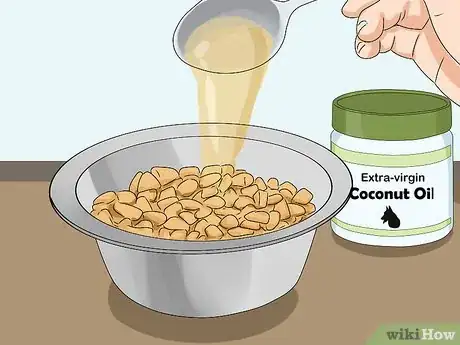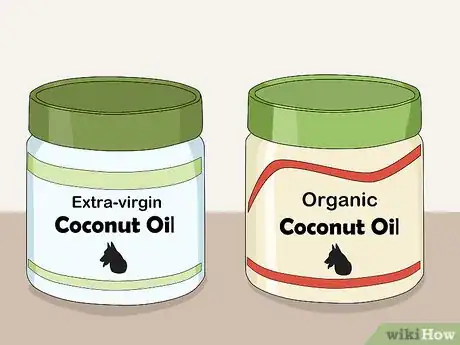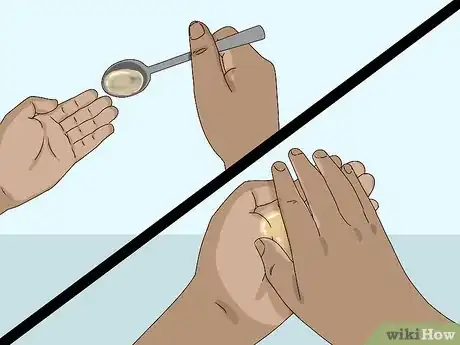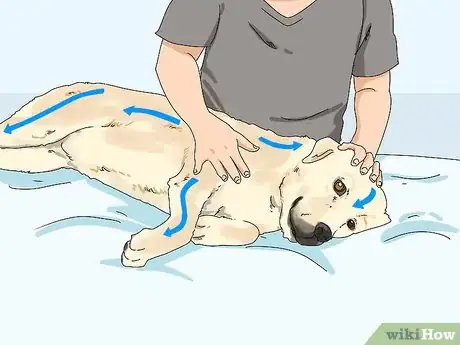This article was co-authored by wikiHow staff writer, Jessica Gibson. Jessica Gibson is a Writer and Editor who's been with wikiHow since 2014. After completing a year of art studies at the Emily Carr University in Vancouver, she graduated from Columbia College with a BA in History. Jessica also completed an MA in History from The University of Oregon in 2013.
wikiHow marks an article as reader-approved once it receives enough positive feedback. This article received 43 testimonials and 92% of readers who voted found it helpful, earning it our reader-approved status.
This article has been viewed 877,985 times.
Learn more...
Coconut oil has become a popular treatment for skin problems. It's antibacterial, anti-fungal, and easy to purchase.[1] While more research is needed to determine how effective (if at all) it is, you can safely give it to your dog. Some believe that feeding your dog coconut oil or rubbing it through their fur can reduce symptoms and improve the look of your dog's coat.
Steps
Feeding Your Dog Coconut Oil
-
1Buy extra-virgin coconut oil. Since your dog will be ingesting the oil, choose the highest quality coconut oil you can find. If possible, purchase organic oil. Avoid buying refined, bleached, and deodorized (RBD) coconut oil because the processing destroys nutrients.[2]
- You can find high-quality coconut oil at grocery stores, pharmacies, and natural food stores.
-
2Give your dog the oil on a spoon or mixed into food. While you can give your dog 1 teaspoon (4 g) of coconut oil for every 10 pounds (4.5 kg) it weighs, you want to gradually work up to this amount. Start by feeding your dog 1/4 of this amount for a few days before you increase the amount. Feed the coconut oil directly off of the spoon or stir it into your dog's food.[3]
- If you feed your dog too much coconut oil right away, it may have diarrhea and indigestion.
- For example, if your dog weighs 20 pounds (9 kg), start by feeding your dog 1/2 teaspoon (2 g) of oil for a few days. Gradually work up to 2 teaspoons (8 g).
Advertisement -
3Balance the omega-3 oils in your dog's diet. Consider your dog's overall diet and ensure that it doesn't get too many essential fatty acids (omega-3s) that are found in coconut oil. If your dog takes a supplement that contains omega-3 oil, alternate days when you give your dog the supplement and coconut oil. Too much omega-3 can cause digestive problems, trouble with blood clotting, and insulin sensitivity.[4]
- For example, if you give your dog an omega-3 oil three days a week, alternate with the coconut oil for the other four days.
-
4Ask the veterinarian about using coconut oil in the long term. Some veterinarians are skeptical about the potential benefits of coconut oil on the dog's skin. Ask your veterinarian about giving your dog coconut oil as part of its regular diet. If your dog is overweight, the vet might recommend that you only give the oil in the short term because coconut oil contains 120 calories for every tablespoon (12 g).[5]
Applying Coconut Oil to Your Dog's Skin
-
1Purchase high-quality coconut oil. Look for an unrefined, extra-virgin, organic coconut oil since it will be higher in nutrients than highly refined coconut oils. Avoid using refined, bleached, and deodorized (RBD) coconut oil. Keep in mind that coconut oil might become liquid if it's in a warm location, but will harden as it cools.[6]
- Buy high-quality coconut oil at grocery stores, pharmacies, and natural food stores.
-
2Warm the oil between your hands. If the coconut oil is in liquid form, spoon about 1/2 teaspoon (2 g) of coconut oil into the palm of one hand. Rub your hands together so they're coated with the oil. If you're using coconut oil that is solid, scoop a small spoonful into your hand and rub your palms together for a minute. The coconut oil will soften and become liquid.
-
3Rub the oil over your dog's skin. Rub your oiled hands over the skin of your dog's back, lower legs, and stomach. You should also rub it over any skin that is dry, itchy, red, or flea-bitten. Apply the oil once or twice a day while your dog is suffering from skin problems.[7]
- Reapply oil to your hands as needed.
-
4Rub coconut oil through your dog's fur. If your dog is suffering from fleas, you'll also need to treat your dog's fur. Rub more coconut oil between your hands and run your fingers through your dog's fur. Remember to rub coconut oil through the fur on your dog's underbelly. Apply the coconut oil once or twice a day while you're dog is infected with fleas.
- You can use the coconut oil for several days or weeks. Continue to apply the coconut oil until the fleas are gone.
-
5Put a sweater on your dog. Don't worry if your dog immediately licks the coconut oil off of its fur or skin, since it's safe to ingest. But if you're concerned that the coconut oil isn't coming into contact with your dog's skin or fur, you might need to put a sweater on your dog. The sweater will prevent the dog from licking off the oil.
Community Q&A
-
QuestionCan I rub coconut oil on my dog's skin?
 wikiHow Staff EditorThis answer was written by one of our trained team of researchers who validated it for accuracy and comprehensiveness.
wikiHow Staff EditorThis answer was written by one of our trained team of researchers who validated it for accuracy and comprehensiveness.
Staff Answer wikiHow Staff EditorStaff AnswerYes, you can rub coconut oil on your dog's skin, as it is safe for most dogs. However, like most creams, oils and lotions first applied to skin, it is a good idea to test a small area first and to wait for 24 hours to see that there is no allergic reaction. If the dog scratches or picks at the area a lot, or you see rashes or other skin reactions, then speak to your vet. If it all looks fine and doesn't bother the dog, it should be fine to use on your dog.
wikiHow Staff EditorStaff AnswerYes, you can rub coconut oil on your dog's skin, as it is safe for most dogs. However, like most creams, oils and lotions first applied to skin, it is a good idea to test a small area first and to wait for 24 hours to see that there is no allergic reaction. If the dog scratches or picks at the area a lot, or you see rashes or other skin reactions, then speak to your vet. If it all looks fine and doesn't bother the dog, it should be fine to use on your dog. -
QuestionHow do I put coconut oil on my dog?
 wikiHow Staff EditorThis answer was written by one of our trained team of researchers who validated it for accuracy and comprehensiveness.
wikiHow Staff EditorThis answer was written by one of our trained team of researchers who validated it for accuracy and comprehensiveness.
Staff Answer wikiHow Staff EditorStaff AnswerUse quality, organic coconut oil. Place a little on your hands and let it warm up, rubbing over your hands to coat them with the oil (it’s good for your skin too!). Rub your oil-coated hands over the dog’s fur into the skin area you wish to add oil to (back, stomach and lower legs are good areas to rub).
wikiHow Staff EditorStaff AnswerUse quality, organic coconut oil. Place a little on your hands and let it warm up, rubbing over your hands to coat them with the oil (it’s good for your skin too!). Rub your oil-coated hands over the dog’s fur into the skin area you wish to add oil to (back, stomach and lower legs are good areas to rub). -
QuestionHow much coconut oil do you give a dog?
 wikiHow Staff EditorThis answer was written by one of our trained team of researchers who validated it for accuracy and comprehensiveness.
wikiHow Staff EditorThis answer was written by one of our trained team of researchers who validated it for accuracy and comprehensiveness.
Staff Answer wikiHow Staff EditorStaff AnswerFor using on skin, you don’t need a lot, as a little goes a long way. Around ½ a teaspoon to 1 teaspoon warmed in your hand should be sufficient to cover an average size dog. You may need a bit more if the dog is quite large; experiment with less, as you can always add more if needed.
wikiHow Staff EditorStaff AnswerFor using on skin, you don’t need a lot, as a little goes a long way. Around ½ a teaspoon to 1 teaspoon warmed in your hand should be sufficient to cover an average size dog. You may need a bit more if the dog is quite large; experiment with less, as you can always add more if needed.
References
- ↑ https://animalwellnessmagazine.com/folliculitis-in-dogs/
- ↑ http://www.dogsnaturallymagazine.com/the-health-benefits-of-coconut-oil/
- ↑ http://www.dogsnaturallymagazine.com/the-health-benefits-of-coconut-oil/
- ↑ http://www.dogsnaturallymagazine.com/the-health-benefits-of-coconut-oil/
- ↑ http://www.petmd.com/blogs/thedailyvet/ken-tudor/2015/july/coconut-oil-over-hyped-super-food-pets-32910
- ↑ http://www.dogsnaturallymagazine.com/the-health-benefits-of-coconut-oil/
- ↑ http://www.dogingtonpost.com/3-natural-remedies-for-dogs-coconut-oil-canned-pumpkin-diatomaceous-earth/
- ↑ http://www.dogsnaturallymagazine.com/the-health-benefits-of-coconut-oil/
About This Article
Before using coconut oil for treating fleas and skin conditions on your dog, make sure to speak with your vet about how much and how often you should give the oil to your dog. Your vet may recommend putting the oil in its food or applying it directly to its skin. To apply the oil to your dog’s skin, rub 1/2 teaspoon of high-quality organic coconut oil between your palms until it melts. Then, rub the oil all over the skin on your dog’s back, lower legs, and stomach, paying special attention to areas with dry skin. For advice on what to do if your dog tries to lick off the coconut oil, read on!



































































